Sabrina Leigh Spencer
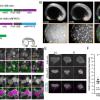 Cell proliferation and quiescence are intimately coordinated during metazoan development. Here, we adapt a cyclin-dependent kinase (CDK) sensor to uncouple these key events of the cell cycle in Caenorhabditis elegans and zebrafish through
Cell proliferation and quiescence are intimately coordinated during metazoan development. Here, we adapt a cyclin-dependent kinase (CDK) sensor to uncouple these key events of the cell cycle in Caenorhabditis elegans and zebrafish through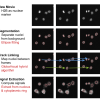 Time-lapse microscopy provides an unprecedented opportunity to monitor single-cell dynamics. However, tracking cells for long periods remains a technical challenge, especially for multi-day, large-scale movies with rapid cell migration, high cell
Time-lapse microscopy provides an unprecedented opportunity to monitor single-cell dynamics. However, tracking cells for long periods remains a technical challenge, especially for multi-day, large-scale movies with rapid cell migration, high cell Multicellular organisms use mitogens to regulate cell proliferation, but how fluctuating mitogenic signals are converted into proliferation-quiescence decisions is poorly understood. In this work, we combined live-cell imaging with temporally
Multicellular organisms use mitogens to regulate cell proliferation, but how fluctuating mitogenic signals are converted into proliferation-quiescence decisions is poorly understood. In this work, we combined live-cell imaging with temporally Despite increasing numbers of effective anti-cancer therapies, successful treatment is limited by the development of drug resistance. While the contribution of genetic factors to drug resistance is undeniable, little is known about how drug-
Despite increasing numbers of effective anti-cancer therapies, successful treatment is limited by the development of drug resistance. While the contribution of genetic factors to drug resistance is undeniable, little is known about how drug-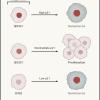 Time-lapse imaging reveals a nuanced role for p21 in cancer cells challenged with chemotherapeutic drugs: cells with either high or low p21 are biased toward senescence, whereas intermediate p21 allows cells to re-enter the cell cycle
Time-lapse imaging reveals a nuanced role for p21 in cancer cells challenged with chemotherapeutic drugs: cells with either high or low p21 are biased toward senescence, whereas intermediate p21 allows cells to re-enter the cell cycle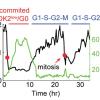 Slow-cycling subpopulations exist in bacteria, yeast, and mammalian systems. In the case of cancer, slow-cycling subpopulations have been proposed to give rise to drug resistance. However, the origin of slow-cycling human cells is poorly studied, in
Slow-cycling subpopulations exist in bacteria, yeast, and mammalian systems. In the case of cancer, slow-cycling subpopulations have been proposed to give rise to drug resistance. However, the origin of slow-cycling human cells is poorly studied, in Ki67 staining is widely used as a proliferation indicator in the clinic, despite poor understanding of this protein’s function or dynamics. Here, we track Ki67 levels under endogenous control in single cells over time and find that Ki67 accumulation
Ki67 staining is widely used as a proliferation indicator in the clinic, despite poor understanding of this protein’s function or dynamics. Here, we track Ki67 levels under endogenous control in single cells over time and find that Ki67 accumulation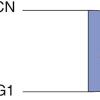 Live-cell imaging demonstrates that a subset of neuroblastoma cells evades chemotherapy-induced death if they are in early G1 phase of the cell cycle at the time of drug treatment and have sufficiently high levels of MYCN.Chemotherapy remains the
Live-cell imaging demonstrates that a subset of neuroblastoma cells evades chemotherapy-induced death if they are in early G1 phase of the cell cycle at the time of drug treatment and have sufficiently high levels of MYCN.Chemotherapy remains the The cell-cycle field has identified the core regulators that drive the cell cycle, but we do not have a clear map of the dynamics of these regulators during cell-cycle progression versus cell-cycle exit. Here we use single-cell time-lapse microscopy
The cell-cycle field has identified the core regulators that drive the cell cycle, but we do not have a clear map of the dynamics of these regulators during cell-cycle progression versus cell-cycle exit. Here we use single-cell time-lapse microscopy The Restriction Point was originally defined as the moment that cells commit to the cell cycle and was later suggested to coincide with hyperphosphorylation of the retinoblastoma protein (Rb). Current cell cycle models posit that cells exit mitosis
The Restriction Point was originally defined as the moment that cells commit to the cell cycle and was later suggested to coincide with hyperphosphorylation of the retinoblastoma protein (Rb). Current cell cycle models posit that cells exit mitosis

